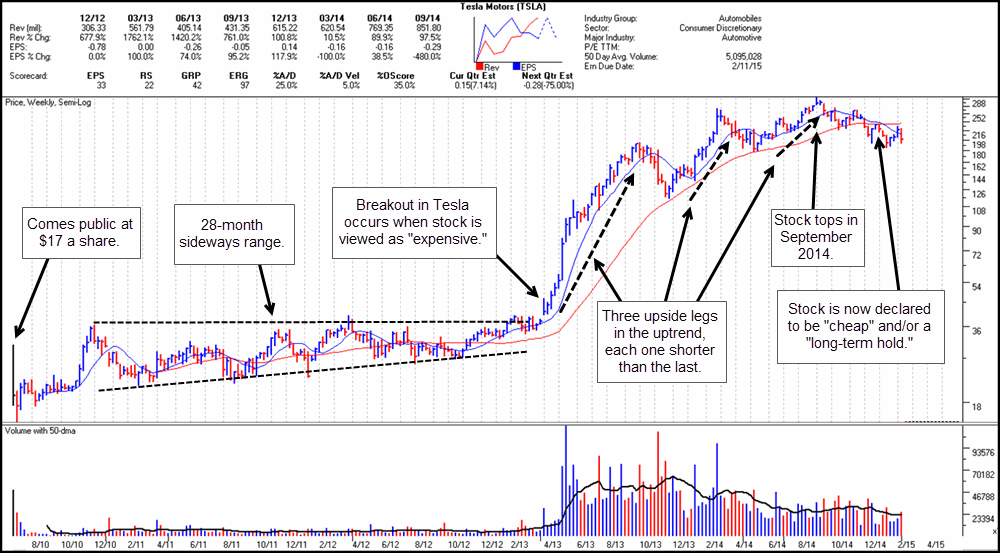In many ways, stocks are like people. They each have their own “life-cycle” of birth, growth, maturity, and eventually death.” What sets stocks apart from humans, however, is that some of the best companies are able to have several life-cycles, as they continually re-invent themselves by developing new, innovative products that in turn drive a new sales cycle and, hence, a new price cycle in the shares of their respective stocks. There are certain common characteristics of “sentiment” that drive these cycles. In this series, we will investigate this phenomenon, starting with one of the most interesting recent examples, Tesla Motors (TSLA).
In the weekly chart of Tesla (see below), we see a company that went public in July of 2010, had a brief upside move in November of 2010, as a certain “coolness factor” caught investors’ imaginations. This brief rally succumbed to a long 28-month sideways periods of choppy moves up and down as enthusiasm for the initial IPO waxed and waned. At this point, a lot of skepticism towards Tesla and its ability to succeed with an “electric-cars-for-the-rich” strategy took hold as investors became increasingly disenchanted with the stock’s lack of progress and the company’s inability to produce any significant profits.

This began to change in 2012 when the company expanded its electric vehicle product line beyond its initial two-seater roadster and introduced the Model S, a luxury sedan that, while still more of a “rich-man’s” car, was more practical and which eventually garnered the company numerous awards, including Motor Trend Car of the Year for 2013. Deliveries of the car began in June of 2012, and strong sales numbers in the first quarter of 2012 triggered a breakout in the stock price in April. In addition, Tesla had tackled the more troublesome infrastructure issue surrounding the need to charge electric vehicles. Tesla came up with an innovative approach, building large “Supercharger” sites around the country that essentially served as “gas stations” for electric vehicles, and making these available at no charge to Tesla owners.
As we can see on the chart above, the initial breakout led to the steepest upside leg in the stock’s ensuing price move, and at this time the stock was a favorite target of, at times, hateful short-sellers who denigrated the company’s business model as fatally flawed and grossly “overvalued” and those who bought the stock as “cult members.” This is actually not uncommon for new, entrepreneurial, and innovative companies as their initial P/E ratios are generally “high” relative to a “market multiple.”
This has been true for any number of other big leaders of the past like Amazon.com, Google, or even Microsoft when they all first emerged on the market scene. The high P/E, rather than being a measure of absolute value, is really a measure of the market’s demand for the company’s future potential, but, still, it attracts know-it-all short-sellers like moths to a porch light.
As Tesla continued it upside price romp, more believers began to join the ranks of the initial Tesla die-hards as the shorts were eventually ground up into so much fertilizer for the stock’s further upside progress. Eventually, the stock put in two more upside legs, each one shorter than the last, before topping in September 2014 at a peak intraday price of 291.42. Now, as is often typical in a stock’s life-cycle, arguments for buying Tesla after the top became more prevalent, and this shift in sentiment is another common characteristic of a stock’s life-cycle, as it gains acceptance and begins to be viewed as a “long-term hold.”
In fact, many begin to argue for purchasing the stock because it is now perceived as “cheap,” which contrasts sharply with the perception of the stock as “expensive” when it first began its meteoric price run closer to the 40 price level. The reality is that the stock was only “cheap” back at 40 when everyone believed it was “expensive,” and only became “expensive” when perception had shifted into believing the final top in the stock and ensuing price decline made the stock “cheap.”
The lesson of the story is simple. In the stock life-cycles of young, innovative, and entrepreneurial companies, they are almost always viewed as “expensive,” and, generally, if one buys a stock that has this “crowd” perception, it can be considered a badge of honor. Once the stock has had a big price move and the crowd begins to view it as “cheap,” or, worse yet, a “long-term hold,” beware! This characteristic shift in sentiment is very often a sign that may harken the beginning of the end for the stock, as it has been for Tesla, at least for now.
#####
If you want to learn more about Gil Morales and The Gilmo Report, please click here.
Related Reading …




